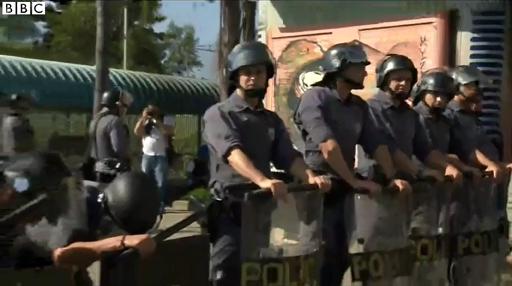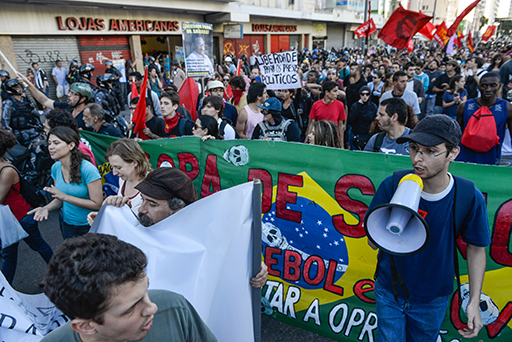5 People power: the World Cup and activism
If you think back to the ways that sport can be political from Session 1, activism was one such theme. While that example referred to athlete activism, this section focuses on how a general population can try to exercise political authority by embarking on activism aimed to disrupt an event.
By 2014, football had become a highly commercial entity with the World Cup being watched by billions worldwide. Beginning in 2013, and continuing throughout the 2014 men’s tournament itself, Brazilian protestors brought global attention to the deprivation and wealth disparity in their nation to an international audience (Nalani Butler and Aicher, 2014).
Watch the BBC news report below which shows clashes between protesters and the Riot police on the opening day of the World Cup.

Transcript: Video 2 Clashes at Sao Paulo, 2014
In response to protests, FIFA acknowledged the civil unrest throughout Brazil before and during the men’s World Cup. In their 2014 Sustainability Report FIFA reference how they ‘explored and debated the origins of the protests, highlighting that football could be used to tackle the social inequalities and injustices underlying the concerns of the Brazilian people’ (FIFA, 2014). Further to this, FIFA implemented a Human Rights Policy in May 2017, which included their commitments to the fundamental freedoms of human rights defenders and protesters. Following the 2018 men’s World Cup in Russia, FIFA suggested that while the spectators and populations in the Russian host cities enjoyed a heightened degree of public freedom during the tournament, there was a small number of instances where, in FIFA’s view, the limitations imposed by authorities on small-scale protests were overly strict (FIFA, 2019).
Arguably the example in Brazil highlights how significant protest may influence the governing body’s recognition of the right to protest. At the time of writing, it remains to be seen if Qatar will afford its visiting spectators a degree of cultural freedom and right to protest.

